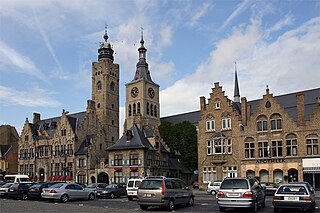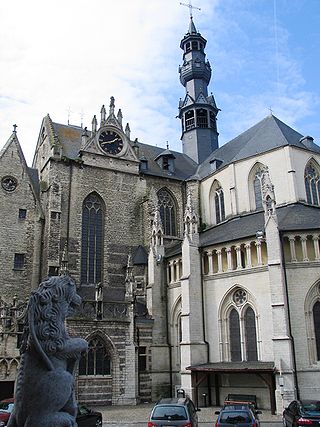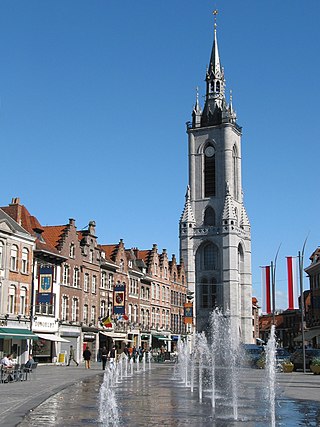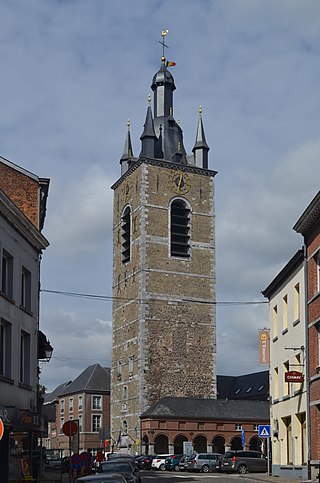
A carillon ( KERR-ə-lon, kə-RIL-yən) is a pitched percussion instrument that is played with a keyboard and consists of at least 23 bells. The bells are cast in bronze, hung in fixed suspension, and tuned in chromatic order so that they can be sounded harmoniously together. They are struck with clappers connected to a keyboard of wooden batons played with the hands and pedals played with the feet. Often housed in bell towers, carillons are usually owned by churches, universities, or municipalities. They can include an automatic system through which the time is announced and simple tunes are played throughout the day.

Diksmuide is a Belgian city and municipality in the Flemish province of West Flanders. The municipality comprises the city of Diksmuide proper and the former communes of Beerst, Esen, Kaaskerke, Keiem, Lampernisse, Leke, Nieuwkapelle, Oostkerke, Oudekapelle, Pervijze, Sint-Jacobs-Kapelle, Stuivekenskerke, Vladslo and Woumen.

Aalst is a city and municipality on the Dender River, 31 kilometres (19 mi) northwest from Brussels in the Flemish province of East Flanders. The municipality comprises the city of Aalst itself and the villages of Baardegem, Erembodegem, Gijzegem, Herdersem, Hofstade, Meldert, Moorsel and Nieuwerkerken; it is the tenth largest city by population with nearly 90,000 inhabitants. Aalst is crossed by the Molenbeek-Ter Erpenbeek in Aalst and Hofstade. The current mayor of Aalst is Christoph D'Haese, from the New-Flemish Alliance party. The town has a long-standing (folkloric) feud with Dendermonde, which dates from the Middle Ages.

Dendermonde is a city in the Flemish province of East Flanders in Belgium. The municipality comprises the city of Dendermonde and the towns of Appels, Baasrode, Grembergen, Mespelare, Oudegem, Schoonaarde, and Sint-Gillis-bij-Dendermonde. Dendermonde is at the mouth of the river Dender, where it flows into the Scheldt. The town has a long-standing folkloric feud with Aalst, south along the same river, which dates from the Middle Ages.

Mechelen is a city and municipality in the province of Antwerp in the Flemish Region of Belgium. The municipality comprises the city of Mechelen proper, some quarters at its outskirts, the hamlets of Nekkerspoel (adjacent) and Battel, as well as the villages of Walem, Heffen, Leest, Hombeek, and Muizen. The Dyle flows through the city, hence it is often referred to as the Dijlestad.

A bell tower is a tower that contains one or more bells, or that is designed to hold bells even if it has none. Such a tower commonly serves as part of a Christian church, and will contain church bells, but there are also many secular bell towers, often part of a municipal building, an educational establishment, or a tower built specifically to house a carillon. Church bell towers often incorporate clocks, and secular towers usually do, as a public service.

Bergues is a commune in the Nord department in northern France.

The Belfries of Belgium and France are a group of 56 historical buildings designated by UNESCO as a World Heritage Site, in recognition of the civic belfries serving as an architectural manifestation of emerging civic independence from feudal and religious influences in the former County of Flanders and neighbouring areas which once were possessions of the House of Burgundy.

The Saint Leonard's Church in Zoutleeuw, Belgium, stands on the former site of a Romanesque chapel erected in 1125 by Benedictines from Vlierbeek Abbey near Leuven. Construction of the present church began around 1231, and additions continued into the 16th century. Rendered mainly in the Gothic style, the building in its oldest parts shows traces of the Romanesque architectural style.

The Cloth Hall is a large cloth hall, a medieval commercial building, in Ypres, Belgium. It was one of the largest commercial buildings of the Middle Ages, when it served as the main market and warehouse for the Flemish city's prosperous cloth industry. The original structure, erected mainly in the 13th century and completed 1304, lay in ruins after artillery fire devastated Ypres in World War I. Between 1933 and 1967, the hall was meticulously reconstructed to its prewar condition, under the guidance of architects J. Coomans and P. A. Pauwels. At 125 metres (410 ft) in breadth, with a 70 metres (230 ft)-high belfry tower, the Cloth Hall recalls the importance and wealth of the medieval trade city. The building now houses the In Flanders Fields Museum. In 1999, it was inscribed on the UNESCO World Heritage List as part of the Belfries of Belgium and France site, in recognition of their unique architecture, role in the advancement of civil liberties, and their civic, not religious, influence.

The Belfry of Ghent is one of three medieval towers that overlook the old city centre of Ghent, Belgium; the other two belonging to Saint Bavo Cathedral and Saint Nicholas' Church. Its height of 91 metres (299 ft) makes it the tallest belfry in Belgium. The belfry of Ghent, together with its attached buildings, belongs to the set of Belfries of Belgium and France, a UNESCO World Heritage Site.

The Belfry of Tournai is a freestanding bell tower of medieval origin in Tournai, Belgium, 72 metres (236 ft) in height with a 256-step stairway. This landmark building is one of a set of Belfries of Belgium and France registered on the UNESCO World Heritage List in recognition of their civic architecture and importance in the rise of municipal power in Europe.

The Belfry of Bruges is a medieval bell tower in the centre of Bruges, Belgium. One of the city's most prominent symbols, the belfry formerly housed a treasury and the municipal archives, and served as an observation post for spotting fires and other dangers.

The Town Hall of Oudenaarde, East Flanders, Belgium, is a landmark building and the seat of that city. Built in a Brabantine late-Gothic style between 1526 and 1537, it is listed as one of the Belfries of Belgium and France, a UNESCO World Heritage Site.

Saint Peter's Church in Leuven, Belgium, is a Roman Catholic church built in the 15th century in the Brabantine Gothic style. The church has a cruciform floor plan and a low bell tower that has never been completed. It is 93 metres (305 ft) long. It is located on the city's 'Grote Markt', opposite the Town Hall. In 1999, the belfry and bell tower of the church was inscribed on the UNESCO World Heritage List as part of the Belfries of Belgium and France site, in recognition of the civil importance and architecture of the belfries in the region.

The Belfry of Kortrijk is a medieval bell tower in the historical centre of Kortrijk, Belgium. One of the city's most prominent symbols, the belfry formerly housed a treasury and the municipal archives, and served as an observation post for spotting fires and other danger. A narrow, steep staircase, accessible by the public without any entry fee, leads to the top of the building, which nowadays leans about a bit to the west. In 1999, the belfry was inscribed on the UNESCO World Heritage List as part of the Belfries of Belgium and France site, in recognition of the civil, not religious, importance and architecture of the belfries in the region.

The Belfry of Namur, also called the Tour Saint-Jacques, is an historical building in Namur, Belgium. The tower, constructed in 1388 as part of the city wall, became a belfry in 1746. It is one of the 56 belfries of Belgium and France classified by UNESCO as a World Heritage Site because of their importance as a representation of civic architecture in Europe and their testimony to the rising and influence of the city.

The Belfry of Mons is one of the more recent among the belfries of Belgium and France. At a height of 87 metres (285 ft), it dominates the city of Mons, Belgium, which is itself constructed on a hill. This belfry, classified in Belgium since 15 January 1936, belongs to the major cultural patrimony of Wallonia. It was inscribed on the UNESCO World Heritage List on 1 December 1999, for its unique architecture, civic importance, and testimony to the birth of municipal influence and power in the area. It is the only one in Belgium that is constructed in Baroque style.

The Belfry of Thuin is a historic building in Thuin, Belgium. Although historically attached to a church, the bell tower has also become a municipal tower, the only belfry of the Principality of Liège. It is one of 56 belfries of Belgium and France that are inscribed on the UNESCO World Heritage List, in recognition of their civic architecture and importance in the rise of municipal power in Europe.





















